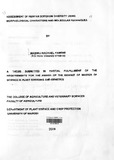Assessment of Kenyan sorghum diversity using morphological characters and molecular techniques
Abstract
Characterization of the available Kenyan sorghum genetic diversity is
important to understand the dynamics of the genetic resources and to improve
and sustain sorghum productivity. The main aim of this study was to assess the
extent and structure of diversity in sorghum landraces from Kenya. Phenotypic
and genotypic data was used to assess diversity in 148 entries consisting of
accessions from Western, Turkana, Coast and Eastern regions and breeders
lines. Morphological characterization showed high yields among the accessions
as revealed by the means of panicle branches (43), panicle length (21cm), and
grain weight (1.5g). Late maturity was also observed as shown by the mean
number of days to 50% flowering (88 days). Positive correlations were found
between all the traits except with days to 50% flowering. All traits showed
significant differences. Number of panicle branches had the highest Broad-sense
heritability of 0.957. The phenotypic PCA scatter plot clustered the accessions
into three groups while the cluster analysis gave two major groups subdivided
into four sub-clusters.
Molecular characterization using 39 SSR/microsateliite markers gave an
average PIC value of 0.54 indicating high polymorphism. The mean diversity
index per locus was 0.57. The markers gave a total of 349 alleles (8.9 alleles per
locus). In AMOVA all variation components were highly significant (P < 0.001).
Diversity among the accessions within the populations was the highest at 56%.
The variability within individual accessions contributed 39% and variability among
geographical origins contributed only 5% of the total diversity. FST value of 0.05
was observed. A high inbreeding level (Fis = 0.59) and a high heterozygozity
deficiency (FIT = 0.61) were observed showing an increased degree of allele
fixation and high homozygosity. The genotypic cluster analysis grouped the
accessions into three clusters, with a genetic distance range of 0.4 to 0.8. PCoA
separated the accessions into three groups. Over all, the study revealed a high
diversity among the different sorghum germplasm from Kenya. However, there
was no appreciable genetic difference between the sorghum sub-populations.
Citation
Master Of Science In Plant Breeding And Genetics,University of Nairobi, 2009Publisher
Faculty of Agriculture, University of Nairobi

